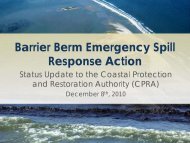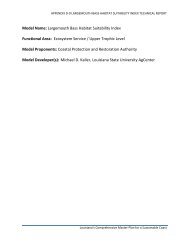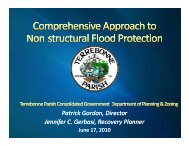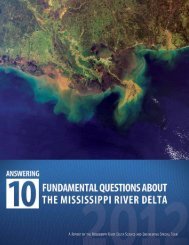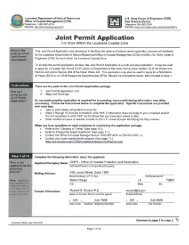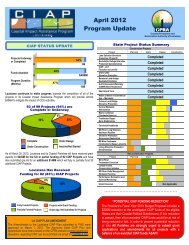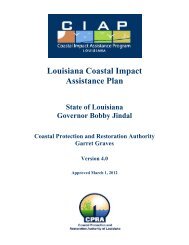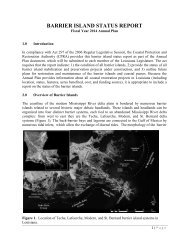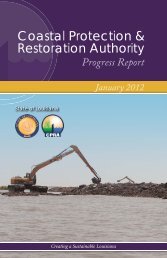Deepwater Horizon Response UAC Transition Plan - Coastal ...
Deepwater Horizon Response UAC Transition Plan - Coastal ...
Deepwater Horizon Response UAC Transition Plan - Coastal ...
Create successful ePaper yourself
Turn your PDF publications into a flip-book with our unique Google optimized e-Paper software.
• VOOs/local fishing fleet will be given priority over contracted OSROs in the demobilization<br />
of assets. VOOs/local fishing fleet shall be employed to maintain,<br />
remove and re-deploy all boom or other protective measures, conduct oil<br />
reconnaissance missions, handle on water logistics, etc.<br />
Action:<br />
1. Incident Commanders shall develop transition plans consistent with this strategic<br />
plan using the following guidelines:<br />
Recall times and estimated time to be on-scene shall be identified for all<br />
critical resources not currently in operational use until completion of hurricane<br />
season.<br />
<strong>UAC</strong> will assist with providing the identified measures to the ICP at each<br />
response level.<br />
The <strong>UAC</strong> will notify all ICs and branches when the permanent well kill is<br />
complete and resources may be adjusted to meet strategic and operational<br />
objectives.<br />
ICs shall report the current <strong>Response</strong> Level to the <strong>UAC</strong> Situation Unit daily;<br />
response levels should be further delineated for each Branch level.<br />
Branches may adjust the response structure as changes in operations and<br />
<br />
response levels dictate with parish approval.<br />
Specific plans for what assets and personnel will be de-mobilized must be<br />
developed and coordinated with each parish for each phase of the transition.<br />
2. Unified Area Command Staff and Section Chiefs and the Aviation Coordination<br />
Command, in coordination with the <strong>UAC</strong> Remote Sensing Coordinator, shall<br />
develop annexes consistent with the guidance of this plan.<br />
3. No changes in <strong>Response</strong> Levels will be executed without coordination and<br />
concurrence of the parish.<br />
4. Create a detail demobilization plan of the VOO’s to include a joint inspection of<br />
these vessels to determine if there are any damages that were a direct result of<br />
their response effort. A process must also be created to immediately create a<br />
claim for said damages<br />
5. Create a mutually agreed upon definition of when a shoreline is to be classified as<br />
“no further treatment.”<br />
6. Create a detailed monitoring plan that will address the following concerns:<br />
a. What long term monitoring will be conducted<br />
b. The frequency of the monitoring<br />
c. Who will conduct the monitoring<br />
d. A map of the sampling points<br />
e. The sampling method<br />
f. The parameters of the sampling and tests<br />
g. Access to the test results<br />
h. The term of the monitoring period<br />
4



